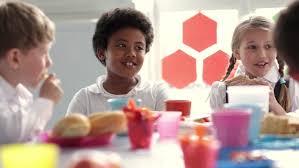School Lunches – Back in the Day
Listen to the Recess! Clip
| Author | Rita Smith |
| Air Date | 9/14/2006 |

School Lunches Transcript
In the March 1877 issue of St. Nicholas Magazine for Boys and Girls, the editor asked her young readers to write to her and describe “what you ordinarily take to school for your noon feeding.” She had noticed that one little girl was eating a lunch of one pop-corn ball, a box of guava jelly, and a pickle! “Such things,” she notes, “form very improper nourishment for growing children to depend upon.” She asked the children to be honest. “Tell me what you actually take. If it be molasses candy and pickles, say so. If it be mince pie and sausages, or plain apples and crackers, tell me frankly. Consider yourself in the light of workers for the public good and let the whole truth come out.”
The letters poured into the St. Nicholas offices, and the results of this solicitation were published in the September 1877 issue. Dodge acknowledged that most of the lunches were very good and included nutritious items like graham bread and fresh fruit, but she was sorry that almost all of the children mentioned that they like pies and only about half mentioned meat. “Pies are popular, I know,” she writes, “but they form a bad diet for children to study on, especially mince-pies which I notice almost all of you select at your favorite. The lard and butter and heavy sweetness of them have the inevitable effect to make brains sluggish and dull. Heads ache and eyes droop and that horrid geography gets the blame or the old arithmetic, instead of the real culprit–pie!”
In the published letters, children mention cold mutton, cake, apples and pears, donuts, hard-boiled eggs, pickled pigs feet, and chocolate cake. One little girl’s favorite lunch included a potted tongue sandwich, an orange and a piece of mince-pie; another’s consisted of an orange, a lemon, a cream-puff, and a great big green pickle. One student reported that eating mince-pie regularly made his face blotchy, and another student reported that one day she persuaded her mamma to let her take a couple of macaroons and a cream puff, but she won’t do it again because that day she had a dreadful headache. “When a girl doesn’t eat properly,” Dodge responds, “every part of [her] cries out at having such stuff administered to it. Her head aches, her eyes ache, her skin feels feverish, her whole system is loaded and oppressed. She goes home at night with the fatal basket empty in her hands, and feels that the day has been a bad one, and that life generally is hard. Her spirits are low, nobody seems kind.Very likely she ends with a nightmare. All this as payment for the brief pleasure of twenty minutes gormandizing! Is it worth while? I don’t believe any of you will say that it is.” She offers some suggestions: bread and butter with cold meat such as chicken, a slice of veal loaf or potted shad, boiled potatoes, plain rice pudding, grated or sliced cheese, cold baked sweet potatoes, a hard boiled egg, a square of fresh gingerbread, and fresh or stewed fruit. She asked school children to take the idea of their proper nutrition seriously. “Who knows,” she says, “what may be the result of proper eating, what sallow, blotched faces may be cleared up; what headaches may be driven away; what rosy cheeks brought into bloom; what school triumphs may follow!”
Sources:
Dodge, Mary Mapes, “School Luncheons,” in St. Nicholas Magazine, March, 1877, p. 354-355.
Dodge, Mary Mapes, “School Luncheons,” in St. Nicholas Magazine, September, 1877, p. 755-759